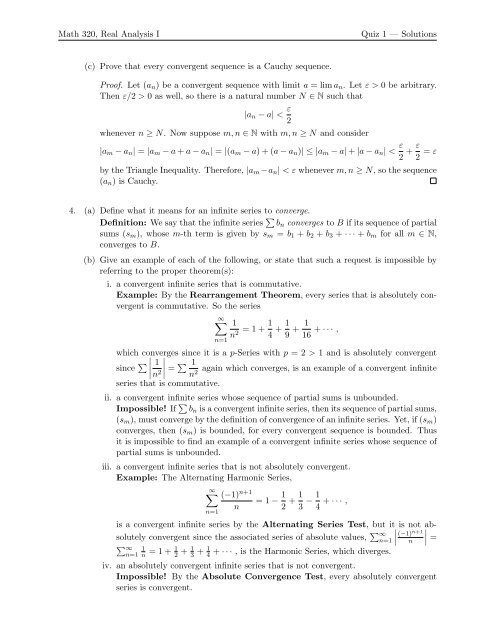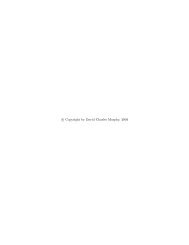Math 320, Real Analysis I Quiz 1 — Solutions 1. (a) Define what it ...
Math 320, Real Analysis I Quiz 1 — Solutions 1. (a) Define what it ...
Math 320, Real Analysis I Quiz 1 — Solutions 1. (a) Define what it ...
You also want an ePaper? Increase the reach of your titles
YUMPU automatically turns print PDFs into web optimized ePapers that Google loves.
<strong>Math</strong> <strong>320</strong>, <strong>Real</strong> <strong>Analysis</strong> I<br />
<strong>Quiz</strong> 1 <strong>—</strong> <strong>Solutions</strong><br />
(c) Prove that every convergent sequence is a Cauchy sequence.<br />
Proof. Let (a n ) be a convergent sequence w<strong>it</strong>h lim<strong>it</strong> a = lim a n . Let ε > 0 be arb<strong>it</strong>rary.<br />
Then ε/2 > 0 as well, so there is a natural number N ∈ N such that<br />
|a n − a| < ε 2<br />
whenever n ≥ N. Now suppose m, n ∈ N w<strong>it</strong>h m, n ≥ N and consider<br />
|a m − a n | = |a m − a + a − a n | = |(a m − a) + (a − a n )| ≤ |a m − a| + |a − a n | < ε 2 + ε 2 = ε<br />
by the Triangle Inequal<strong>it</strong>y. Therefore, |a m −a n | < ε whenever m, n ≥ N, so the sequence<br />
(a n ) is Cauchy.<br />
4. (a) <strong>Define</strong> <strong>what</strong> <strong>it</strong> means for an infin<strong>it</strong>e series to converge.<br />
Defin<strong>it</strong>ion: We say that the infin<strong>it</strong>e series ∑ b n converges to B if <strong>it</strong>s sequence of partial<br />
sums (s m ), whose m-th term is given by s m = b 1 + b 2 + b 3 + · · · + b m for all m ∈ N,<br />
converges to B.<br />
(b) Give an example of each of the following, or state that such a request is impossible by<br />
referring to the proper theorem(s):<br />
i. a convergent infin<strong>it</strong>e series that is commutative.<br />
Example: By the Rearrangement Theorem, every series that is absolutely convergent<br />
is commutative. So the series<br />
∞∑ 1<br />
n 2 = 1 + 1 4 + 1 9 + 1 16 + · · · ,<br />
n=1<br />
which converges since <strong>it</strong> is a p-Series w<strong>it</strong>h p = 2 > 1 and is absolutely convergent<br />
since ∑ ∣ ∣ ∣∣<br />
1 ∣∣∣<br />
n 2 = ∑ 1 again which converges, is an example of a convergent infin<strong>it</strong>e<br />
n2 series that is commutative.<br />
ii. a convergent infin<strong>it</strong>e series whose sequence of partial sums is unbounded.<br />
Impossible! If ∑ b n is a convergent infin<strong>it</strong>e series, then <strong>it</strong>s sequence of partial sums,<br />
(s m ), must converge by the defin<strong>it</strong>ion of convergence of an infin<strong>it</strong>e series. Yet, if (s m )<br />
converges, then (s m ) is bounded, for every convergent sequence is bounded. Thus<br />
<strong>it</strong> is impossible to find an example of a convergent infin<strong>it</strong>e series whose sequence of<br />
partial sums is unbounded.<br />
iii. a convergent infin<strong>it</strong>e series that is not absolutely convergent.<br />
Example: The Alternating Harmonic Series,<br />
∞∑ (−1) n+1<br />
= 1 − 1 n 2 + 1 3 − 1 4 + · · · ,<br />
n=1<br />
is a convergent infin<strong>it</strong>e series by the Alternating Series Test, but <strong>it</strong> is not absolutely<br />
convergent since the associated series of absolute values, ∑ ∞<br />
n=1 ∣ (−1)n+1<br />
n<br />
∣ =<br />
∑ ∞<br />
n=1 1 n = 1 + 1 2 + 1 3 + 1 4<br />
+ · · · , is the Harmonic Series, which diverges.<br />
iv. an absolutely convergent infin<strong>it</strong>e series that is not convergent.<br />
Impossible! By the Absolute Convergence Test, every absolutely convergent<br />
series is convergent.
















